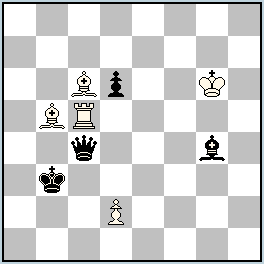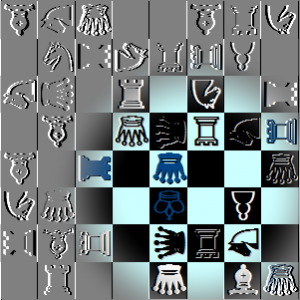|
|
Original Problems (page 140)Original fairy problems published during 2012 will participate in the informal tourney JF-2012. The site is mostly about fairies, but h# and s# are also welcomed for publication! Please send your problems to my e-mail: julia@juliasfairies.com Go to ?List of Problems; ?Page 139 ; ?Page 141 |
No.210 – h#2 by Pierre Tritten – A Meredith with an excellent Take & Make content and dynamics! (JV)
Definition:
Take & Make: Having captured, a unit must immediately, as part of its move, play a non-capturing move in imitation of the captured unit from the capture-square. If no such move is available, the capture is illegal. Promotion by capture occurs only when a pawn arrives on the promotion rank as the result of a take&make move. Checks are as in normal chess: after the notional capture of the checked K, the checking unit does not move away from the K’s square.
|
No.210 Pierre Tritten
France
original-29.12.2012
 h#2 2 solutions (5+4)
Take & Make Solutions: (click to show/hide)
|
The diagrams are made on WinChloe and its Echecs font is used for Logo design



Nice idea, but the promoted wB is disturbing, although it is not perceivable in the mates. Black “Make”-part in first solution is played on a white diagonal, so it is not only a technical accident.
Diagonal-orthogonal echo is not present in the “Make”-part of white mating moves (bQ is not fully used for T&M).
Also, Bristol recently becomes variously interpreted.
The bishop looks promoted, but in T&M two lightsquared bishops can be result only of making after taking, no promotions are necessary. It is a similar situation e.g. to four black knights in Andernach chess problems.
Hm, I did not think of it. I can’t get used to a freedom that fairy composers seemingly have, or simply take.
However, fairy pieces and conditions offer so much more possibilities than orthodox rules. Some aesthetic standards, at least, should be equal. But which standards, that’s up to the experienced.
hm…. Bristol? More like ‘Follow-my-leader’. Nice.
You are right Ram, there is no Bristol. Author pointed as a Mixed Bristol the moves 1.Qe3 – 2…R:e3 and 1.Qe2 – 2…B:e2, but actually this called “Pseudo Bristol” and it occurs only in the second solution because there both pieces playing over the critical square d3.
The difference between Bristol and Pseudo Bristol is that in the second one the rear piece capture the first one after playing over a critical square.
For example – in the second solution of the problem above after 1.Qe2 if white plays 2…Bd3 this is Bristol, but if they play 2…B:e2 (as in the solution) this is Pseudo Bristol.
Nevertheless, the problem is nice.
Well, WinChloe definition of two-colored Bristol is : a piece leaves a square x. A piece of other color moves in the same way, crossing x. Here, x is c4 and both wB and wR cross c4…
Thanks for your comments!
Indeed this seems to be the definition. I was more used to bristols where the front piece is not captured. Very nice problem. Thanks for the clarification and the problem 🙂
So, WinChloe is a supreme authority? Or that’s only a joke?
In the absence of a Supreme Authority of fairy chess, one has to refer to something. Using WinChloe, I refer to WinChloe, that’s all. In the same way, when composing Take & Make problems, I use no more than two bishops of the same color, whichever the color of their squares 🙂
Promotion is perfectly legal in orthodox play and acceptable (may be even thematic) during the solution. But promotion during a pre-diagram play are considered as a weakness.
4 black Knights may be a result of legal pre-diagram Andernach-play, but they also could be legally promoted in orthodox pre-diagram play.
Orthodox standards do not allow too easy constructions where the composer may put on the board anything.
What is a crucial difference in standards of orthodox and fairy problems?
Dear Pierre, of course WinChloe is very good program and its definitions are helpful. But sometimes (even in the FIDE Album) there are unclear or uncomplete definitions.
Please look again “the example” in my comment above and you will get the difference between (Bicolored) Bristol and Pseudo Bristol.
But I repeat – it doesn’t matter Bristol or Pseudo Bristol, your problem is very nice in my opinion!
Thanks, Diyan, I’ve learned Pseudo Bristol!
Well Pierre, I mentioned the supreme authority when Seetharaman changed his opinion just because WinChloe says so.
There is a supreme authority, it is the composer himself. If he knows what he wants and manages to realize that, everything could be clear, without naming the themes. Definitions are often short and insufficient to explain the complete logic and strategy of some theme which they describe. Several good examples should be seen and analyzed for a full understanding of some definition. And definitions could be simply wrong, after all. A bit of curiosity and logic might help to improve the definitions.
I would not even think about putting two orthodox white-square bishops on the diagram, but that is obviously my own trouble. So, my whole comment should be reduced to:
“A nice idea”.
I should have waited to consult better authority 🙂 The article by Milan Vukcevic on Bristols in the Matplus website was not helpful, neither was his book. But the recently published Encyclopedia (by Milan Velimirovic) gives a better and generally accepted definition. (I had lent it to a friend.)
“A line piece moves along the line clearing it for like-motion piece, which follows it in the same direction”.
The words –‘”follows it” — clearly rules out capture of the front piece. I think “pseudo Bristol” (suggested by Diyan) is a suitable term for these types of clearances.
“Pseudo Bristol” is not my suggestion Ram. It is term which I know from Petko Petkov some years ago. You can see it in his excellent book “The Art of Composing Selfmates” 2007 (edited and prepared by Mike Prcic). There are explained (with definitions and many examples) the different type of Bristols:
– White Bristol
– Black Bristol
– Bicolor Bristol (Blak/White; White/Black)
– Pseudo Bristol
The difference of the Pseudo Bristol is that there the thematic piece “A” plays to the square “y” on thematic line “X” and then thematic piece “B” plays (usually with capture) to the SAME square “y”. (As in the second solution of Pierre’s problem above – piece A is Qc4, piece B is Bb5, square y is e2)
I am complete agree with that clasification.
You’re right, Nikola, I’ll be more careful naming themes in the future.